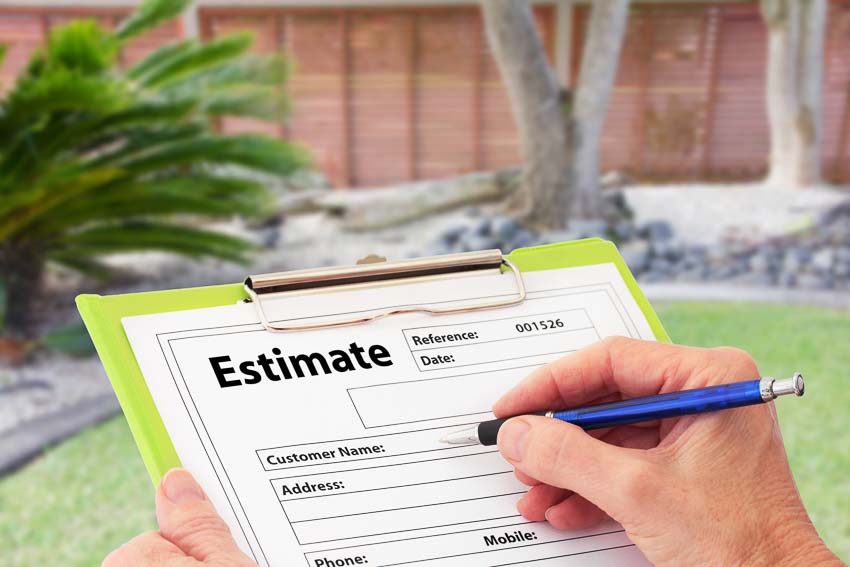The Ultimate Guide to Different Types, Their Advantages, and Pricing
Fencing costs vary greatly depending on the materials you use and the size of your yard. When you’re trying to calculate how much a fence will cost, you must consider several important factors that can mean a difference of thousands of dollars. Discover your options by learning about the different types and the average cost of fencing.
The Importance of Fencing
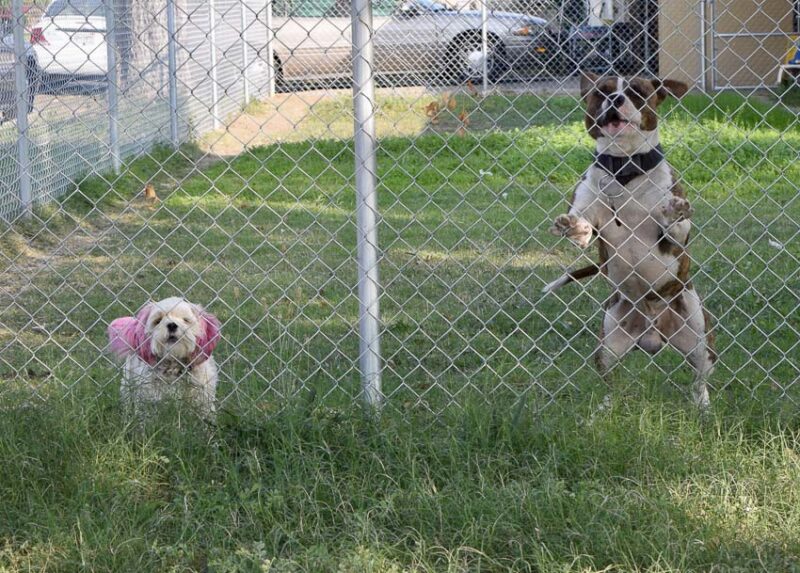
Fences solve problems. They can make your home more private, create boundaries between you and your neighbor, and make your yard a safe place for pets and children to play.
In areas with high crime rates, fences provide security for your family and protect your belongings.
Fences can block wind and noise, contain livestock, and keep pests out of your yard. One of the most common reasons for building a fence is to enhance your home’s curb appeal.
Types of Fencing and Costs
The average cost of fencing is about $3,000. However, the actual cost will vary because you can choose from many different types of fencing.
The type of fence you choose will ultimately determine the cost of your project, which can end up being anywhere between $500 and $8,500 with materials and installation.
In addition to the upfront cost of installing a fence, there are long-term maintenance and replacement costs that you should consider when choosing the best type of fencing for your yard.
Wood Fencing
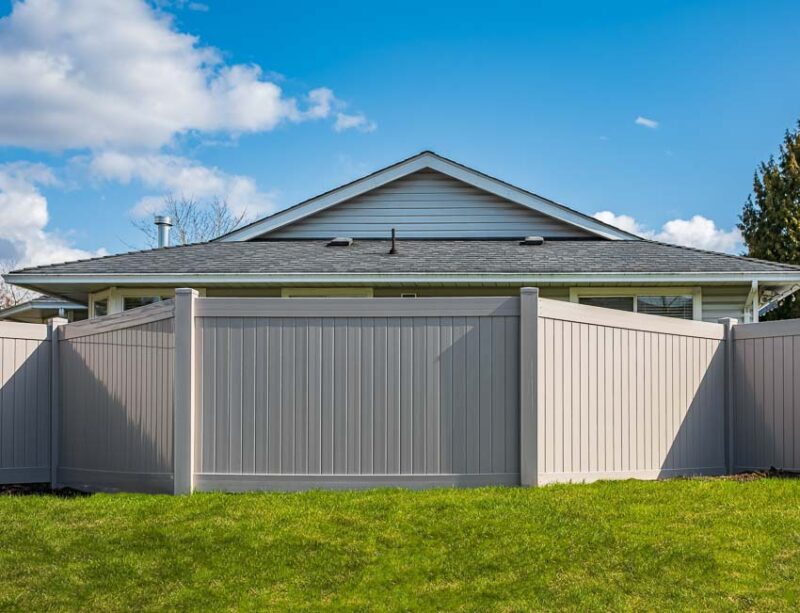
Many homeowners choose wood fencing because it is versatile, affordable, and provides a clean, natural look. Since wood is easy to install, maintain, and repair, it’s a top choice for DIY fence installations.
There are many wood fencing options, and with skill and ingenuity, you can achieve a variety of aesthetically pleasing styles.
When it comes to durability, wood offers an exceptional price-to-benefit ratio. You can choose from many species of wood, including popular choices like redwood and cedar, for long-lasting fences that add value to your home for years.
Vinyl Fencing
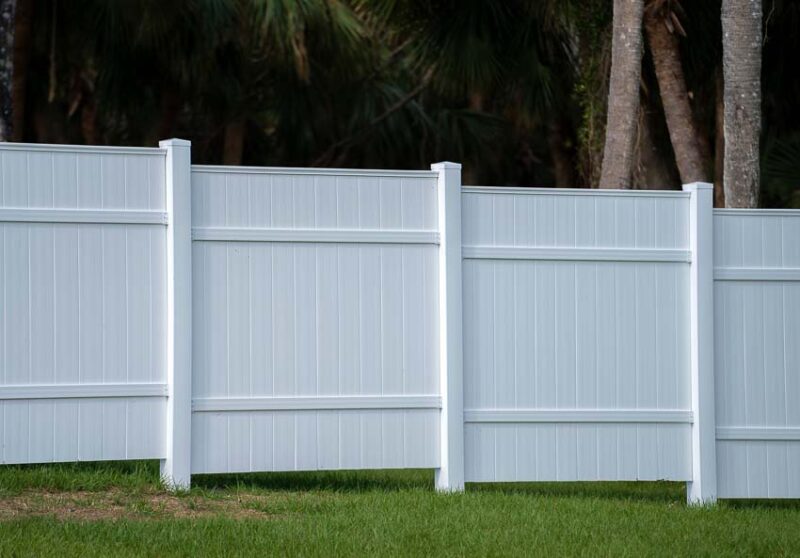
While vinyl fencing is less versatile than wood, it offers several advantages for many homeowners.
There is almost no maintenance required with vinyl fencing, and it is a durable option that will last 20 to 30 years. It costs more to install than traditional wood fences, but in the long run, the cost of owning a vinyl fence may be less than the cost of a wood fence.
Vinyl fence panels are available in various styles and types, from privacy to picket fences. Many homeowners choose white vinyl fences because of their elegant appearance, but you can choose from many different colors to match your home’s exterior.
Chain Link Fencing
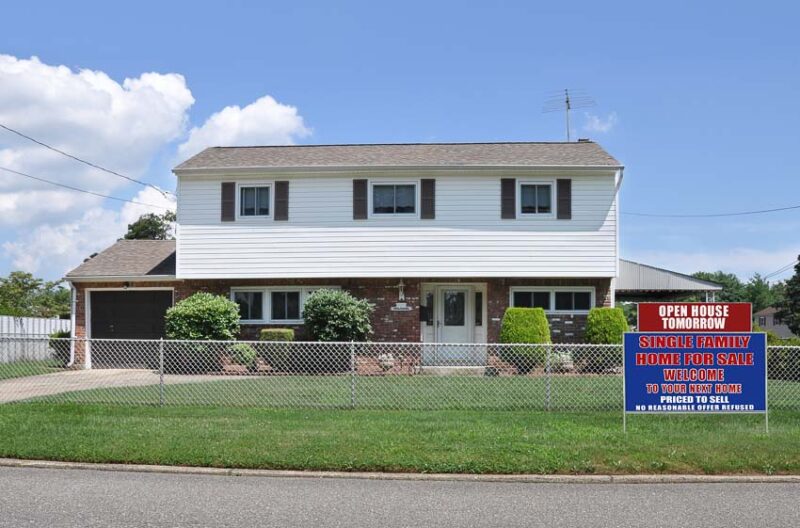
One of the most affordable types of fencing is chain link fencing, and it is an excellent option when security is your top concern. Whether you’re trying to keep children and animals in or intruders and pests out, chain link fencing is a popular choice.
Besides the cost of chain link fences, there are several other advantages to this type of fencing.
It is quick and easy to install and will last up to 20 years with very little maintenance required. Unless you add privacy slats, a chain link is not an ideal privacy fence. But that can be an advantage when you want visibility so you can see who is approaching or driving by your yard.
Aluminum Fencing
Aluminum fencing is an attractive option when you want a lightweight security fence without sacrificing your view. This type of fencing has a similar look to wrought iron or steel, but it costs much less. Aluminum is easy to maintain, and in addition, resistant to UV rays, insect infestations, decay, and rust.
Aluminum fencing doesn’t have the strength of steel and iron fences, so it isn’t suitable if you’re worried about intruders breaking in. However, it can keep pets and small children safe in your yard.
It’s also one of the most aesthetically pleasing types of fences. You can get aluminum fencing in several different colors and styles for a classic look at a fraction of the cost of other types of fences.
Wrought Iron Fencing
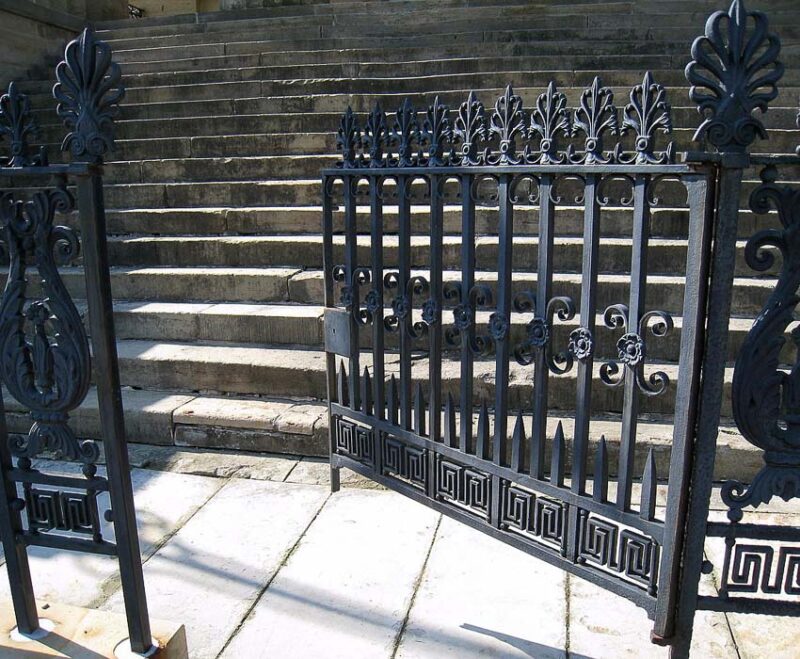
Wrought iron fences are among the most durable and appealing types of fencing for your home. Incredibly, wrought iron can last over a century, making it a valuable and sustainable fencing option.
There are some disadvantages to wrought iron fences, however.
It won’t provide any privacy and can’t block out noise. It’s also more difficult to install than other types of fences, and it requires regular maintenance.
A wrought iron fence is prone to corrosion in areas with high humidity and rainfall. In areas with a lot of moisture, wrought iron may require maintenance once or twice a year to stay in top condition.
While you’re budgeting, check out our Guide to Lawn Care Cost.
Factors that Affect the Average Cost of Fencing
The type of fencing you choose is one of the most significant factors affecting the final cost of your fence, but it’s not the only one. The size of your yard also greatly impacts your overall project cost.
Additionally, factors like height, style, and design directly affect the cost of fence materials. Finally, when it comes to installing your fence, factors such as site preparation, terrain, and the cost of labor in your region will help determine the actual cost of your fence.
Length and Height of the Fence
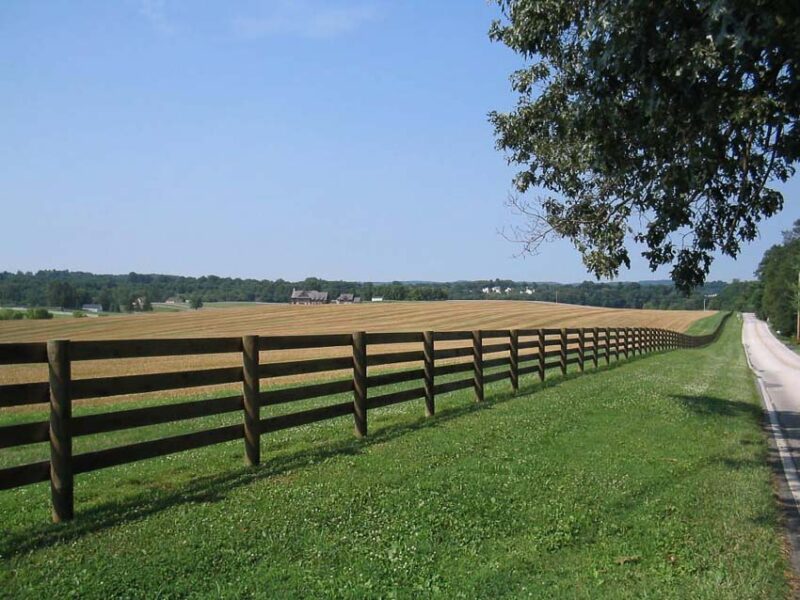
The more materials your fence requires, the higher the cost.
Standard fence heights are 6 feet tall, but they can be more or less depending on the fence’s purpose. Local regulations and covenants can also help determine fence heights.
How much area you’re fencing will determine the length. Large fence projects can have a lower fence per foot cost, but they will cost more overall.
Type of Material
When you’re working with a tight budget, there are budget-friendly options available that can help lower the cost of fence per foot. These include chain link and wire fencing materials. In addition, some inexpensive fencing materials are easy to install, which makes them even more cost-effective fencing options.
Style and Design
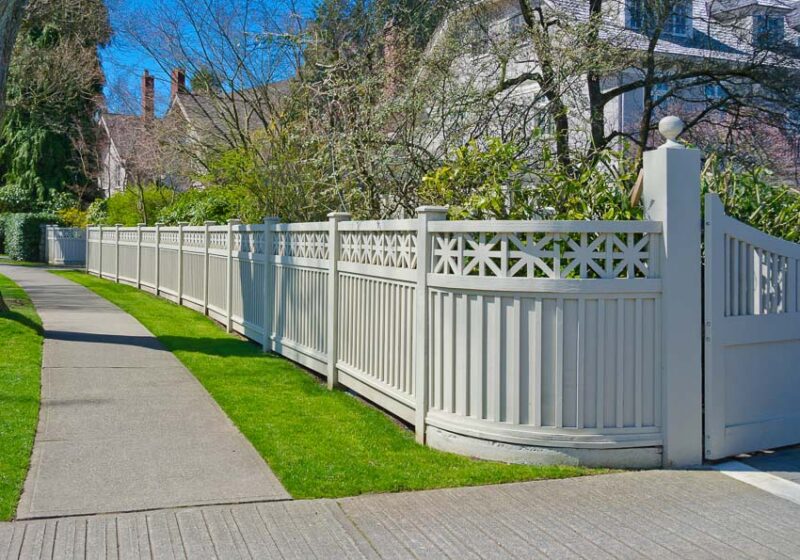
Your fence design can add to the cost of materials and installation.
No matter what type of fencing material you choose, ornate designs, fancy gates, and complex features will add to the cost of fencing. Curves are more difficult to install than 90-degree corners and will add to the installation cost.
Site Preparation
Several factors can affect the cost of site preparation for your new fence.
If you have an existing fence that you need to remove, it will add about $3 to $5 per linear foot to the project cost. If you need to clear the area for your fence, you may need to factor in related services like tree removal costs.
Post Spacing
The more posts you have, the greater your fencing costs will be. Fence posts are usually spaced 4 to 8 feet apart, depending on the type and height of the fence.
Location and Terrain
Flat land is the easiest land to build fences on. Additionally, if you have a sloped yard, it will cost more and take longer to fence.
You can also expect to pay more for installing a fence on a property that is far from city limits or in a region with higher labor costs.
Permit and Zoning Requirements
Depending on your local municipality or HOA, you may need a permit before installing a fence. Fence permits can cost as little as $20 in some areas and up to $400 in others.
Detailed drawings can also cost you and may be required when you submit your fence plan for approval.
Average Cost of Fencing
Average fencing costs are calculated based on a standard fence height of 6 feet. To estimate the cost of an 8-foot tall fence, add 25 to 35% of the standard fence cost. Shorter fences, which average about 4 feet tall, will cost about 25 to 35% less than a 6-foot fence.
Below are some common types of fences and the average cost per foot. Some fences are made with a combination of different materials, which can help lower the cost.
Wood Fencing: $10-$30 per foot
Since there are so many different types of wood fencing available, the cost of wood fences varies greatly. Expect to pay anywhere from $10 to $30 per linear foot, depending on the type of wood you choose and other factors that affect fencing costs.
Vinyl Fencing: $20-$40 per foot
The average cost of a vinyl fence is between $20 and $40 per linear foot, depending on the height and type of fence panels you choose. You’ll save money yearly on a vinyl fence, though, because it won’t need painting or staining.
Chain Link Fencing: $8-$18 per foot
The average cost of a chain link fence is $8 to $18 per linear foot. The most significant factors affecting the cost of chain link fences are how tall your fence will be and how many gates you install.
A popular height for chain link fences is 4 feet, but you can install them at heights between 3 feet and 20 feet, depending on the application.
Aluminum Fencing: $20-$30 per foot
You can choose between three grades of aluminum fence, including residential, commercial, and industrial.
Of course, features like decorative details and gates will add to the cost of your aluminum fence, but for most residential applications, the average cost of aluminum fencing is about $20 to $30 per linear foot.
Wrought Iron Fencing: $25-$30 per foot
Most wrought iron fences that are sold today are made from a steel alloy of carbon and iron, which is less susceptible to corrosion than solid wrought iron. It’s also less expensive, costing between $25 and $30 per linear foot.
Taller wrought iron fences cost considerably more and range between $33 and $36 per foot.
Gates are also a significant cost factor in wrought iron fences. A single-swing gate will only cost about $350, whereas a driveway gate will cost several thousand.
Benefits of Fencing
It’s important to consider the advantages and disadvantages of fencing types when choosing the best one for your yard.
Having a fence around your yard has many benefits, and some types of fencing meet several needs. For example, you can use standard wooden fences for security and privacy. Moreover, they’re aesthetically pleasing, adding to the value of your property.
Privacy
Creating a backyard oasis to enjoy your outdoor spaces at home is more popular than ever.
Having a privacy fence means you can relax and enjoy your yard without worrying about noisy neighbors and unwanted visitors. The cost of a privacy fence can vary significantly depending on the materials you choose.
Security

Fences provide security by establishing property boundaries and containing children and pets. They also keep out intruders of all kinds, including pests like feral cats and raccoons. If security is your primary reason for fencing, your best choices are metal security fences like chain link and wrought iron fences.
Safety
A fence around your yard makes your family safer in a number of different ways.
Privacy fences that prevent visibility into your yard can protect your children and home from intruders. When unwanted visitors can’t see what’s inside, they are less likely to intrude, which reduces the potential for harm to your family.
Security fences that block access also make your home safer.
Aesthetics
There is an almost endless variety of styles of fence to choose from when you are fencing your property. You can include design elements from other parts of your home and property that create cohesiveness and make your yard more beautiful.
Property Value
When your fence is aesthetically pleasing or adds privacy to your backyard space, it can increase your property value. If you live in an area where break-ins are common, adding a chain link security fence will also enhance the value of your property and give you peace of mind.
If you end up selling your home, a security fence can make your home more appealing to buyers with pets and small children.
FAQs about Different Types and the Average Cost of Fencing
What Factors Affect the Average Cost of Fencing?
The two most significant factors that affect the cost of fencing are the materials you use and the size of your yard. However, several factors can further influence the final cost of your fencing project, like the length, height, and location.
Can I Install a Fence Myself to Save Money?
Many people DIY fence installation to save money. Some types of fences are easier to install, like wood, vinyl , and chain link. Other types, like wrought iron and ornate wooden fences, require more installation skills.
What is the Best Type of Fencing For My Property?
To find the best type of fencing for your property, assess your family’s fencing needs. There are many types of fence materials and styles to choose from, and some fence types will be more suitable for your specific needs than others.
Will Installing A Fence Increase My Property Value?
An attractive, well-built fence will add value to your property, particularly if it provides benefits like security, safety, and privacy for your home and family. It can also make your home more attractive to prospective buyers.
How Long Does A Fence Last?
Many types of fences last 20 to 30 years. The most durable fences are wrought iron, concrete, or brick and mortar, lasting up to 100 years.

